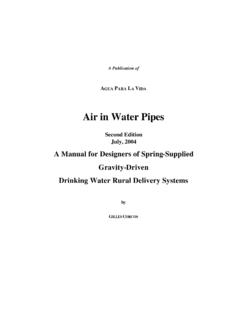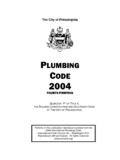Transcription of Condition Assessment of Underground Pipes, April 2015
1 Condition Assessment of Underground Pipes April 2015. With excerpts from: Condition Assessment of Wastewater Collection Systems, EPA/600/R-09/049. EPA New England Water Infrastructure Outreach provides tools, examples, and technical assistance for water infrastructure operators and managers, local officials, and other decision-makers for more effective and sustainable water infrastructure management. For more information see Why perform a Condition Assessment of your Underground infrastructure? Every day in communities across the United States millions of gallons of human and industrial waste are sent through complex Underground sewer systems that empty into wastewater treatment plants.
2 These systems operate all day, every day, to convey polluted water to treatment plants that clean it, and contribute to a healthy environment for our families. One of the challenges of maintaining these wastewater collection systems is that so much of the process takes place Underground , out of view. Most municipal sewer systems are at least 60 years old and many communities have sewers that are older than 100 years. Given the age of our sewer systems, many communities and utilities are turning their attention to assessing the Condition of their Underground pipes and associated infrastructure.
3 A Condition Assessment is an investment these valuable community assets. It's also an investment in managing risk. Knowing the structural Condition of your assets will allow you to avoid emergencies, prioritize repair and replacement projects, and plan for the future. Condition Assessment is an ongoing process (see figure below from Condition Assessment of Wastewater Collection Systems, EPA/600/R-09/049). To assess the Condition of a sewer system, data and information are gathered through observation, direct inspection, investigation, and indirect monitoring and reporting.
4 An analysis of the data and information helps determine structural and operational issues, and performance of the system. Condition Assessment also includes failure analysis to determine the causes of infrastructure failures and to develop ways to prevent future breakdowns. Condition Assessment enhances the ability of utilities to make technically sound judgments regarding asset management. Some utilities presume that older pipe must be in poorer Condition than newer pipe , which is not always the case. There are many examples showing 80 year old pipe in excellent Condition and 30 year old pipe near failure.
5 The only way to know for sure is to take a look - perform a Condition Assessment . 1. Knowing how your collection system really works will reveal maintenance and capacity issues before they become maintenance problems. Implementing a pro-active program based on information and systematic Assessment leads to preventive maintenance decisions, rather than reacting to emergencies, and removes some of the politics and second-guessing from decision-making. Performing a Condition Assessment has a cost, but being able to organize the assets of your system by maintenance and replacement needs is an essential step toward better management.
6 A variety of methods have been developed for performing Condition assessments, but they generally follow a similar progression of steps: setting objectives for the Condition Assessment , identification of assets and available data, asset inspection, data analysis, and decision making. This is similar to EPA's Capacity, Management, Operations and Management (CMOM) program for collection systems. CMOM. programs include defined goals, use of information-based approaches to set priorities, evaluation and insurance of adequate capacity, development of a dynamic, strategic approach to preventive maintenance and conducting periodic program audits to identify program deficiencies and ways to address those deficiencies.
7 1. Program Development Introduction The first step when developing a Condition Assessment program is to determine what you want to achieve and how you want to use the program. Improved service, regulatory compliance, operation and maintenance ease, efficiency, risk management, and/or financial budgeting and forecasting, are among many goals of Condition Assessment programs. For many utilities, identification of high risk pipes or areas where a catastrophic failure could lead to extensive service disruptions and health or environmental damage is a priority.
8 A risk-based Condition Assessment program would focus on specific pipes and areas that present these types of risk. The design of the program should consider how the results of the Condition Assessment will be used to make decisions and achieve your goals. Key performance indicators (KPIs) - that will be used to determine progress - would be defined at this step. KPI's often focus on three categories: Service, Expenditure, and Investment. Preliminary objectives for performing a Condition Assessment could include: understanding the structural Condition , performance, and/or progression of deterioration ( remaining service life) of the assets.
9 Condition Assessment has costs and benefits, some of which are captured in the lists below. Costs of Condition Assessment include: Equipment and labor costs to conduct field inspections, monitoring equipment and data collection Labor costs before and after field work for planning, data analysis and reporting Cost of service disruptions due to inspection work. Specific benefits of a formal Condition Assessment program may include: Early identification of problems (resulting in use of less expensive repair methods). Reduced emergency consequences by identifying and addressing previously unknown problem areas Reduced O&M costs ( , by identifying and cleaning only the dirty pipes during operation and maintenance programs).
10 Avoided emergency costs due to scheduled preventive maintenance Avoided service disruptions by up-front scheduling of preventive maintenance 2. Avoided or mitigated Sanitary Sewer Overflows (SSOs) or pipeline breaks and associated costs from environmental and property damage Avoided public health costs Improved planning and prioritizing of rehabilitation and replacement projects Reduced backlogs of deferred maintenance Identification and prediction of future Capital Renewal needs More effective and efficient operations and maintenance. 2. Asset Inventory In developing the Condition Assessment program, it is essential to compile an inventory of the assets to be assessed.
















